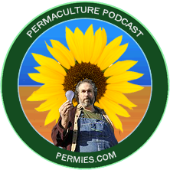In 1990 I was experimenting with potatoes grown in raised beds, figuring it would be easier to weed and harvest them if they were higher up. I took eight straw bales and made a rectangular bed filling the inside with soil and
compost. The potatoes did really well and I had a good harvest that year. The interesting part is what happened later. The next Spring I moved away to college and didn't see the garden for two seasons. When I did get back for a visit in the Fall of 1992 I went out to where the raised bed had been and saw a mass of potato plants growing by themselves, when I investigated I saw that the soil in the middle mostly had weeds in it, the potatoes were growing out of the old straw bales I had used to make the walls of the raised bed. When I pulled the bales apart they were loaded with big healthy russets, and there was a nice deverse little ecosystem in there especially near the bottoms of the old bales. This was in Sequim, WA. which is in the rain shadow of the Olympic Mountains, summers are drought conditions for agriculture yet the old straw bales had kept the potatoes moist and healthy. After seeing the thread about huglekulture (spelling?) I'm thinking straw bales may work for that type of raised bed much easier, better, and faster than wood logs. The bales are more uniform, they hold water like sponges, they rot quickly on the inside yet with the bindings they hold their shape fairly well even after a couple of seasons. Straw bales are made from stalks that might otherwise be burned off if farmers don't have buyers interested in the bales. If buying bales is difficult, I think a person could use a sythe to cut tall field grasses and make large bundles that could be used in similar fashion. Has anyone tried using bales for the huglekulture beds? If so, I would like to know how it worked out and whether my experience was a fluke. Oh. one other thing; I'm also wondering if anyone has tried inoculating straw bales with spore to grow mushrooms?









